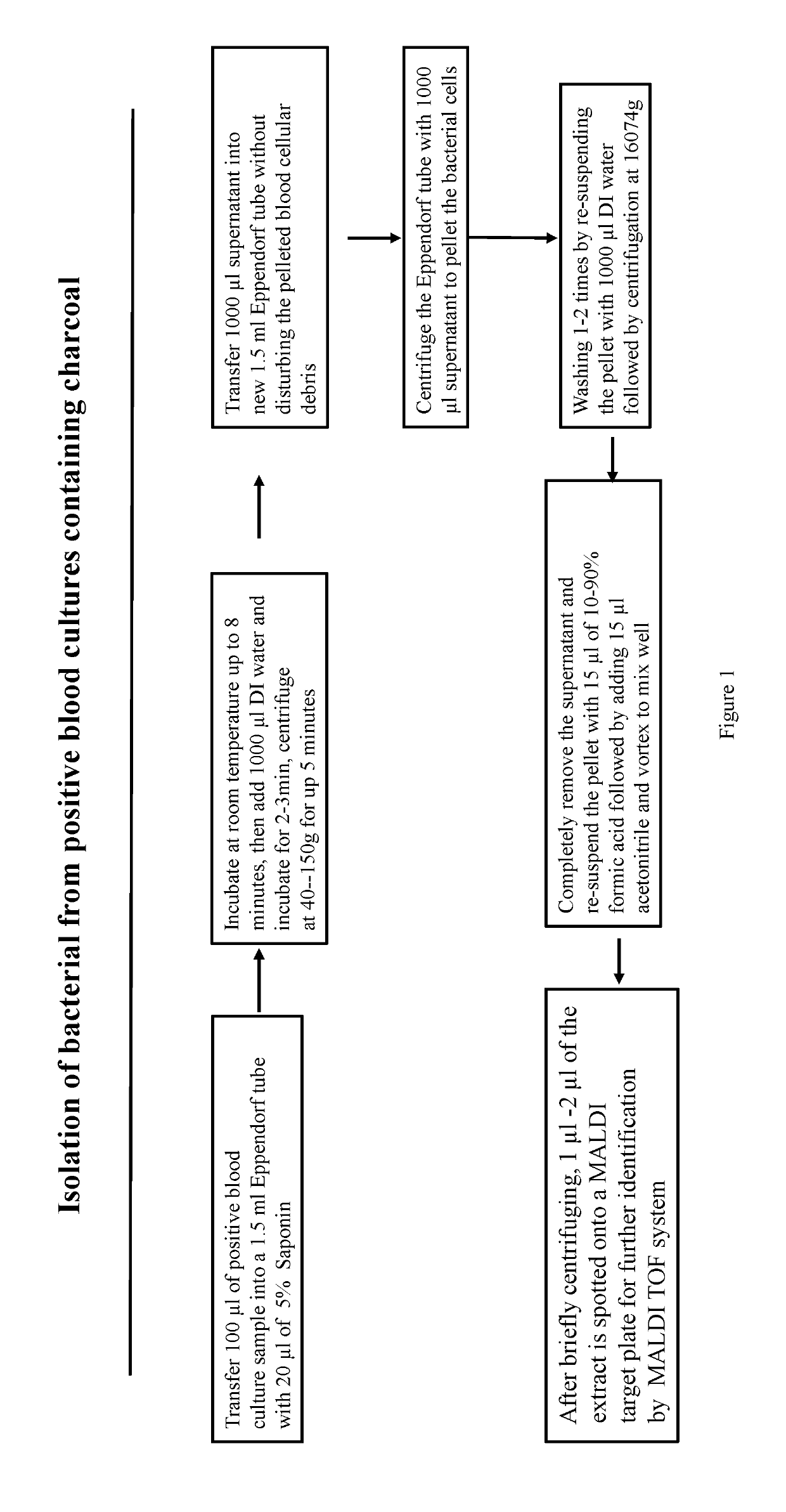Method for rapid and direct identification of microbial pathogen from positive culture sterile body fluids using mass spectrometry
a technology of sterile body fluid and microbial pathogen, which is applied in the field of rapid and direct identification of microbial pathogen from positive culture sterile body fluid using mass spectrometry, can solve the problems of affecting the subsequent identification of mass spectrometry, gram-positive microorganisms that do not work well with sepsityper, and limited methods for direct identification of microbial pathogens from blood culture. , to achieve the effect of accurate mass
- Summary
- Abstract
- Description
- Claims
- Application Information
AI Technical Summary
Benefits of technology
Problems solved by technology
Method used
Image
Examples
example 1
[0014]Isolation of Bacterial Strains from Positive Aerobic BacT / ALERT FA Charcoal Blood Culture Bottle for Mass Spectrometry Identification
TABLE 1Microbial identification by MALDI-TOF versus Classical ID / VITEK2from Biomerieus FAN ® media with activated charcoalNumber ofisolatesCorrect IDCorrect IDMicroorganismanalyzedVITEK2MALDI TOFAcinetobacter baumannii222Enterococcus faecium111Enterococcus faecalis111Escherichia coli222Enterobacter cloacae333Klebsiella pneumoniae444Staphylococcus epidermidis333Staphylococcus aureus444Staphylococcus warneri222Streptococcus pneumoniae220Stenotrophomonas maltophilia222Total262624
[0015]A total of 26 positive aerobic BacT / ALERT FA bottles from our routine diagnostic laboratory were consecutively identified by VITEK 2 with a statistical probability >99% according to the manufacturer's instructions and analyzed by direct mass spectrometry. The samples were prepared with the method below. Results of direct MAI DI-TOF MS from positive BacT / ALERT bottles a...
example 2
[0018]Isolation of Bacterial Pathogens from Positive BD BACTEC™ Plus-Aerobic Bottle for Mass Spectrometry Identification
[0019]A total of 28 positive BD BACTEC™ Plus(resin)-Aerobic bottles from our routine diagnostic laboratory were consecutively identified by VITEK 2 with a statistical probability ≥99% according to the manufacturer's instructions and analyzed by direct mass spectrometry. The samples were prepared with the method below. Results of direct MALDI-TOF MS from positive BD BACTEC™ Plus (with resin)-Aerobic bottles and \TREK 2 are shown in Table 2.
[0020]For the MAT DI TOF sample preparation, 100 μl of each sample was combined with 20 μl of 5% saponin in an Eppendorf tube, and the mixed sample was incubated at room temperature for up to 8 minutes to lyse the human blood cells. Then 1000 μl of DI water was added into the tube to completely lyse the blood cells by incubating at room temperature for 3 minutes, followed by centrifugation at 700 rpm (46.6×g) for 1 minute to remov...
PUM
| Property | Measurement | Unit |
|---|---|---|
| time | aaaaa | aaaaa |
| mass spectrometry | aaaaa | aaaaa |
| concentrations | aaaaa | aaaaa |
Abstract
Description
Claims
Application Information
 Login to View More
Login to View More - R&D
- Intellectual Property
- Life Sciences
- Materials
- Tech Scout
- Unparalleled Data Quality
- Higher Quality Content
- 60% Fewer Hallucinations
Browse by: Latest US Patents, China's latest patents, Technical Efficacy Thesaurus, Application Domain, Technology Topic, Popular Technical Reports.
© 2025 PatSnap. All rights reserved.Legal|Privacy policy|Modern Slavery Act Transparency Statement|Sitemap|About US| Contact US: help@patsnap.com


